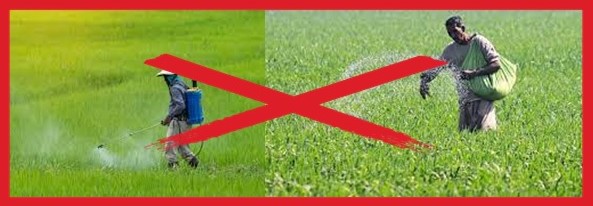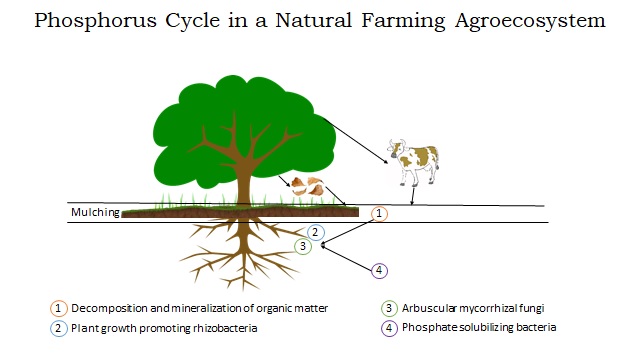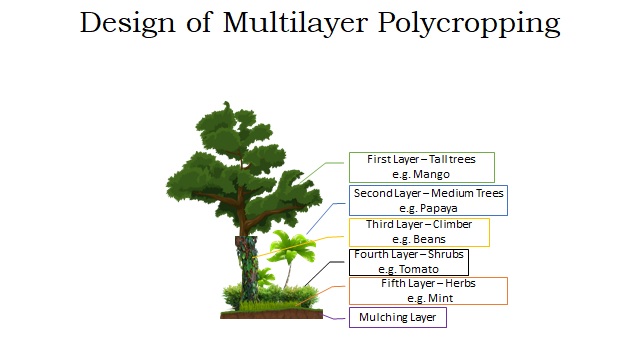No-Till:
Tilling or digging the soil always destroys soil structure, soil water holding capacity, soil organic matter, soil biodiversity, and soil health. Tillage overturns the soil layers and exposes the lower soil to sun and air which destroys soil organic matter by oxidation and kills the soil microorganisms (fungi and bacteria) and other organisms (earthworms) by sun drying. As the living components of soil (plants, animals, and microorganisms) are responsible for soil health, the destruction of soil organisms and their habitats destroys soil health and makes the soil dead. Therefore, avoiding tillage (no-till) is always helpful for preserving soil structure, soil organic matter, soil biodiversity, and soil health. However, in natural farming agroecosystems, earthworms do the soil turning most efficiently without disturbing the soil structure, soil mulching, or soil moisture.

No Off-farm Inputs:
Natural farming agroecosystems are completely self-sufficient and self-reliant in crop production and crop protection. It restores the natural biogeophysical cycles (such as soil temperature cycle and soil water cycle) and biogeochemical cycles (such as carbon cycle, nitrogen cycle, phosphorus cycle, and potassium cycle) to maintain soil health, plant health, animal health, human health, and environment health in their best conditions. Therefore there is no need for application of any external inputs in natural farming for maximising crop production. Moreover, the application of chemical fertilizers or bio-fertilizers disturbs the functioning of native microorganism biodiversity in soil (Game Theory). Natural farming agroecosystems maintain a carefully planned biodiversity of plants, animals, and microorganisms that automatically maintains natural control among the populations of insect pests, predators, parasites, diseases, antagonists, and weeds in crops. Application of pesticides, biopesticides, fungicides, antibiotics, and herbicides disturb this ecological balance and develop resistance against these pesticides to cause more severe epidemics on crops. Therefore avoiding all sorts of external inputs is beneficial for both crop production and crop protection in natural farming. Elimination of external inputs also reduces the cost of production of crops significantly and helps to maximize crop yield, crop quality, and profit for the farmers. This is why natural farming is also known as zero-budget natural farming (ZBNF) or do-nothing agriculture.

No Irrigation:
Natural farming agroecosystems are self-sufficient in respect of their water requirements and there is no need for artificial irrigation for crop production. Natural farming follows no-till, mulching, and cover cropping to maximize cloud seeding, induce rainfall, rainwater harvesting, reduce run-off, harvesting of atmospheric water, infiltration of rainwater in soil, recharge of water to the underground water aquifers, moderating soil temperature, reduce evapotranspiration from the soil surface, ultimately to maintain soil water level constantly at field capacity throughout the year for optimum crop growth and reproduction.
Traditional Plant Breeding:
About 10,000 years ago, indigenous people started plant
domestication and plant breeding all over the world to ensure the
supply of food close to their settlements. They have domesticated
more than 7,000 plant species and have developed thousands of unique
plant varieties that made agriculture sustainable and resilient for
thousands of years.
The indigenous method of plant breeding includes
(1) collection of better plant genotypes and their wild relatives
from other farmers or wild sources,
(2) conservation of these plant
genotypes in decentralized seed banks (now known as Vavilov
Centres),
(3) facilitating random open pollination of these
genotypes through biotic (such as native pollinator biodiversity)
and abiotic factors (such as wind) to achieve natural hybridization
of crops,
(4) facilitating mutation and somatic mutation of the
genotypes,
(5) characterization and selection of new elite genotypes
by the actual farmers according to their own need and preference,
(6) preservation of seed in special containers,
(7) seed exchange(free of cost),
(8) seed diffusion,
(9) seed migration and finally
(10) naming the plant varieties based on their useful characters.
This traditional system of plant breeding follows a complete cycle
of continuous improvements of plant varieties in their place of
origin as well as in their place of adoption. Natural farming
agroecosystems should follow this traditional system of plant
breeding to achieve self-reliance and for the development of unique,
exclusive, and exquisite plant varieties for individual farmers.

Traditional Animal Breeding :
Man has started the domestication and breeding of animals since 11,000 BCE for sourcing their food, clothing, transport, and protection. They were successful in domesticating more than 50 animal species and developed hundreds of unique breeds of animals that supported sustainable agriculture for thousands of years. They followed controlled mating of animals and selection of better individual animals for the development of distinct and useful animal breeds. Natural farming agroecosystems follow this decentralized and diversified system of traditional animal breeding for the development of unique, exclusive, and exquisite animal breeds for individual farmers.
Water Harvesting:
Water is the lifeblood of agriculture. Natural farming uses all possible techniques to maximize rainwater harvesting and conservation of water in the soil to become self-reliant and avoid artificial irrigation in crop production. Natural farming constructs well-designed permanent water harvestings structures such as contour bunds and trenches, wells, ponds, lakes, ditches, and wetlands, using locally available materials such as stones or soils. Natural farming follows no-till, mulching, and cover cropping to maximize rainwater harvesting, dew harvesting, eliminating runoff, infiltration of rainwater in soil, recharge of water in the underground aquifers, reduction soil temperature, reducing evapotranspiration from the soil surface and conservation of water in soil ultimately to maintain soil water level constantly at field capacity throughout the year.

Mulching:
Laying out dry leaves or other organic materials over the soil surface and maintaining them throughout the year is known as mulching. Mulching provides several regulating ecosystem services. Mulching protects the soil from soil erosion caused by sun, rain, and wind, helps with rainwater harvesting, reduces runoff, moderates soil temperature, reduces the rate of evapotranspiration from the soil, recycles organic matter through decomposition and mineralization by soil organisms such as earthworms, fungi and bacteria to provide plant nutrients and suppresses weeds.
Probiotics:
Preparation of native microbial culture by fermenting household materials in crude formulations under ambient conditions to use them in soil or on plants for enhancing crop production and crop protection in agriculture is known as prebiotics or probiotics (opposite to antibiotics). The use of probiotics in agriculture is a common traditional practice among indigenous people all over the world. For example, Bokashi, Cohol Amino Acid, Compost Tea, Fermented Fruit Juice, Fermented Plant Juice, Fish Amino Acid, Jeevamrut, Lactic Acid Bacteria, and Nettle. Application of probiotics is optional in natural farming but sometimes it is proved very helpful in quickly restoring the populations of native microorganism biodiversity in degraded or barren lands.
Cover Cropping:
In the natural farming agroecosystems, farmers maintain live green plants all over the soil surface throughout the year, which is known as cover cropping. Similar to mulching, cover cropping provides multiple ecosystem services. It helps protect the soil from soil erosion by sunlight, raindrops, or high winds, helps with water harvesting, check runoff, increases water infiltration and conservation in soil, suppression of weeds, and recycling plant nutrients through the decomposition and mineralization of plant nutrients in the soil by soil organisms and microorganisms. Legume cover crops enrich the soil by fixing atmospheric nitrogen in symbiotic association with Rhizobium bacteria.
Multilayer Polycropping:
Mixed cropping of multiple crops and stacking them in multiple
layers of canopies are known as multilayer poly cropping. The number
of crops can range from 3 (Three Sisters) to 256 (Forest Garden) and
the canopy layers can range from 5 (ZBNF) to 7 (Food Forest).
Multilayer poly cropping gives a natural farming agroecosystem the
structure and function of a natural forest ecosystem. Multilayer
polycropping can harvest maximum sunlight and rainwater, provide
habitat to maximum animal biodiversity, can maximise crop yield,
crop quality, crop diversity, and farmers' income. The following
steps should be followed to establish an ideal multilayer poly
cropping system:
1. Plant rating and ranking -
crop species and cultivars are evaluated based on the valuation of
their ecosystem services to assign them a rating and rank them to
prepare a priority list of the best crop varieties for each natural
farm. The plant varieties are evaluated based on various economic
and ecological parameters. Economic parameters are crop yield,
marketable qualities of the crop, the season of harvesting, the
price of the crop, and market size (price x volume). The ecological
parameters are plant height, spacing, canopy density, provision for
food and habitat for animal biodiversity (particularly pollinators,
insect predators, parasitoids, and birds), inducing cloud and
rainfall, fixing atmospheric nitrogen in symbiotic association with
bacteria, resistance or tolerance against biotic and abiotic
stresses like insect pests, diseases, drought, excess rainfall, and
high wind velocity.
2. Crop plant portfolio optimization-
crop plant portfolio of a natural farming agroecosystem should be
optimized by applying Modern Portfolio Theory. This theory states
that in the case of any income-generating asset portfolio,
diversification always reduces risk and increases returns. For
example, monoculture (1 crop) bears 100% risk, intercropping (2
crops) bears 50% risk and polycropping of 20 crops or more bears the
lowest level of risk. The crop portfolio is optimized for the
uniform production of diversified crops throughout the year and the
uniform production of pollen and nectar for the pollinators
throughout the year.
3. Landscape design -
while designing the landscape of a natural farming agroecosystem,
two ecological theories should be kept in mind "the area effect on
biodiversity" and "the edge effect on biodiversity". A larger area
of a natural farm can accommodate a larger biodiversity of plant and
animal species. The boundary or edge between two distinct habitats
or ecosystems harbors more biodiversity than each of the individual
habitats. For example, the boundary of a pond contains more
biodiversity than either in water or the land. Therefore the
boundaries are maximised by curving the lines of the ecotones to
maximise the biodiversity of the agroecosystem. The position of
different components of the farm such as green fencing, farm roads,
ponds, fencing, hedgerow, farmhouse, farmstay, car parking, cattle
shed, apiary, orchard, and watch tower are laid out carefully to
build ecological niches for maximum biodiversity of animals.
4. Execution -
while planting the trees or sowing seeds or bringing in the farm
animals in the natural farming agroecosystem, ecological theories
such as "ecological succession" and "carrying capacity" should be
kept in mind to design a balanced food web and food pyramid.

Bee Keeping -
About 70% of the crops are fully or partially dependent on insect pollinators for biotic pollination of their flowers for fruit setting and to improve their fruit quality. For example, without pollination apple fruit setting will be hampered and fruits will be small and deformed. Honey bees are the best-known pollinators of crop plants. Native honey bee species and other native pollinator biodiversity are more efficient pollinators than imported exotic honey bees but their honey yield is less. Some crop plants, that provide the maximum amount of pollen and nectar to the native pollinator biodiversity throughout the year are called pollinator magnet plants. These pollinator magnet plants are included in the natural farming agroecosystem to maximize the incidence of native pollinator biodiversity and to maximize the biotic pollination of crops. The biodiversity of pollinator magnet plants converts the natural farming agroecosystem into a pollinator sanctuary or pollinator hotspot that serves the conservation of biodiversity. Honey bees also produce natural multiflora honey, a high-value agricultural produce. Natural farming uses native honey bee colonies by attracting them to the box with natural lures such as a piece of an old beehive or Cymbidium floribundum orchid.
Mixed Animal Husbandry
In a natural farming agroecosystem, various living organisms, namely
plants, animals, microorganisms, and man remain interrelated with
each other by their food relations. All these organisms occupy their
respective trophic levels in a complex food web that maintains a
balanced food pyramid. Green plants (autotrophs) form the base of
the food pyramid, herbivorous animals form the second layer (primary
consumer), carnivorous animals form the third and fourth layer
(secondary and tertiary consumer) and the microorganisms form the
final apex layer (detritivore) of the food pyramid. Therefore
creation of the most effective plant biodiversity is the first
important step in the natural farming agroecosystem. Subsequently,
animal biodiversity (heterotrophs) are introduced within the plant
biodiversity in tandem with the increase in the carrying capacity of
the green plants. Animal biodiversity in the natural farming
agroecosystem is created by man by bringing in domesticated farm
animals as well as by allowing wild animals to occupy their
respective ecological niches in the agroecosystem
The methods include
1. rating and ranking of animal biodiversity based on the valuation
of their ecosystem services,
2. selection of the best breeds of domestic animals,
3. designing the best portfolio of domestic animals,
4. quarantine of animals for diseases and pests,
5. introduction of animal biodiversity in natural
6. farming agroecosystem based on its carrying capacity (after
deducting the amount of food harvested for man) and following the
rules of ecosystem succession,
7. growing the most favorite food plants of the animal biodiversity,
8. use of poultry birds for control of insect pests and parasites of
cattle,
9. use of predators (such as mongoose) for control of snakes and
10. use of medicinal plants as food for prevention of diseases in
animals.

Mixed Aquaculture
Freshwater ponds are an essential component of the natural farming agroecosystem which provides drinking and bathing water to the animal biodiversity as well as provide habitat for the aquatic plant and animal biodiversity. These water bodies should maintain a mixed culture of native species of fish, shrimps, crabs, mussels, slugs, oysters, turtles, frogs, and other edible aquatic animals and plants.
Direct Marketing
The products of the natural farming agroecosystems are exclusive and exquisite premium agricultural commodities. The existing system of agricultural marketing has no provision for the price discovery of exclusive and exquisite crops. Therefore, direct marketing is the only option for the farmers to sell these products directly to the consumers, eliminating all marketing intermediaries. Direct marketing can be carried out through agri-tourism, gate sales, farmers markets, home delivery, or online marketplace.
Eco-Agritourism
The appearance of a natural farming agroecosystem resembles a botanical garden, a zoological garden, a biodiversity park, a supermarket of agricultural products, and a tourist destination. Farmers can monetize these cultural ecosystem services by promoting eco-agritourism in the natural farming agroecosystem, which can become one of the main sources of income for the farmers. People living in urban settings love to visit natural farming agroecosystems to experience the beauty and healing power of nature and biodiversity. Tourism helps with the advertising and marketing of natural farming products. Additional provisions for training, workshops, seminars, exhibitions, competitions, paintings, photography, meditation, naturopathy, bird watching, fishing, self-harvesting of fruits, self-cooking, and serving facility can enhance customer experience and success in eco-agritourism.